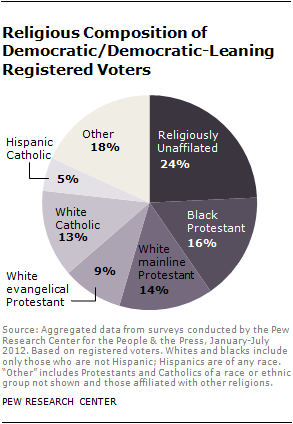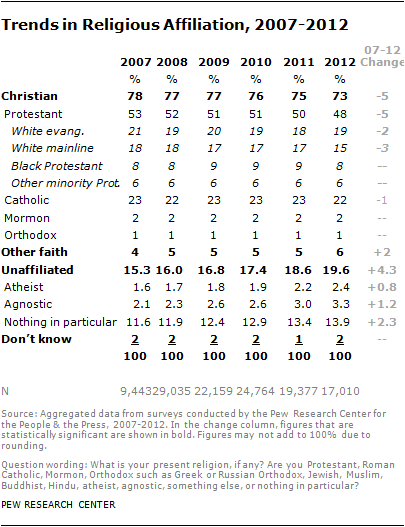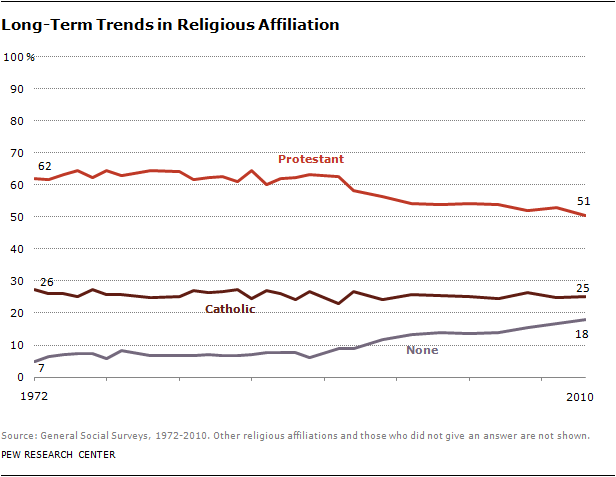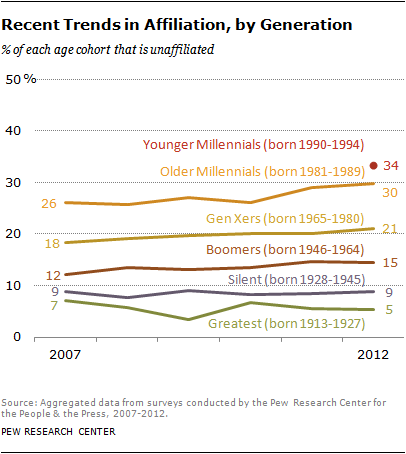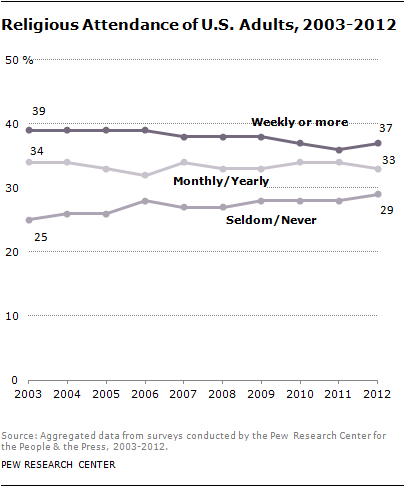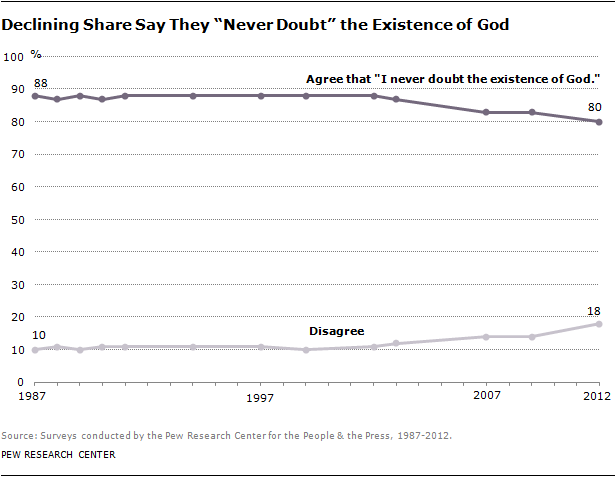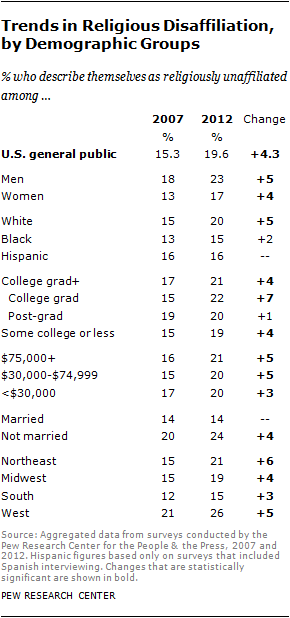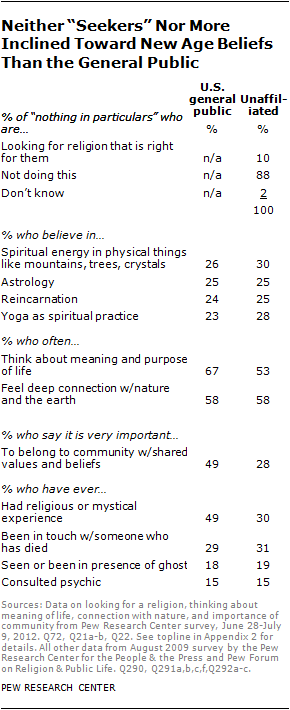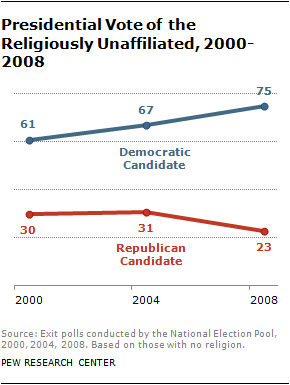“nones” on the Rise
The Pew Forum on Religion and Public Life
This large and growing group of Americans is less religious than the public at large on many conventional measures, including frequency of attendance at religious services and the degree of importance they attach to religion in their lives. However, a new survey by the Pew Research Center’s Forum on Religion & Public Life, conducted jointly with the PBS television program Religion & Ethics NewsWeekly, finds that many of the country’s 46 million unaffiliated adults are religious or spiritual in some way. Two-thirds of them say they believe in God (68%). More than half say they often feel a deep connection with nature and the earth (58%), while more than a third classify themselves as “spiritual” but not “religious” (37%), and one-in-five (21%) say they pray every day. In addition, most religiously unaffiliated Americans think that churches and other religious institutions benefit society by strengthening community bonds and aiding the poor. With few exceptions, though, the unaffiliated say they are not looking for a religion that would be right for them. Overwhelmingly, they think that religious organizations are too concerned with money and power, too focused on rules and too involved in politics.
The growth in the number of religiously unaffiliated Americans – sometimes called the rise of the “nones” – is largely driven by generational replacement, the gradual supplanting of older generations by newer ones.4 A third of adults under 30 have no religious affiliation (32%), compared with just one-in-ten who are 65 and older (9%). And young adults today are much more likely to be unaffiliated than previous generations were at a similar stage in their lives.
These generational differences are consistent with other signs of a gradual softening of religious commitment among some (though by no means all) Americans in recent decades. Pew Research Center surveys conducted over the last 10 years, for example, find modest growth in the number of people who say they seldom or never attend religious services, as well as a declining number who say they never doubt the existence of God. In addition to religious behavior, the way that Americans talk about their connection to religion seems to be changing. Increasingly, Americans describe their religious affiliation in terms that more closely match their level of involvement in churches and other religious organizations. In 2007, 60% of those who said they seldom or never attend religious services nevertheless described themselves as belonging to a particular religious tradition. In 2012, just 50% of those who say they seldom or never attend religious services still retain a religious affiliation – a 10-point drop in five years. These trends suggest that the ranks of the unaffiliated are swelling in surveys partly because Americans who rarely go to services are more willing than in the past to drop their religious attachments altogether.
With their rising numbers, the religiously unaffiliated are an increasingly important segment of the electorate. In the 2008 presidential election, they voted as heavily for Barack Obama as white evangelical Protestants did for John McCain. More than six-in-ten religiously unaffiliated registered voters are Democrats (39%) or lean toward the Democratic Party (24%). They are about twice as likely to describe themselves as political liberals than as conservatives, and solid majorities support legal abortion (72%) and same-sex marriage (73%). In the last five years, the unaffiliated have risen from 17% to 24% of all registered voters who are Democrats or lean Democratic. (See religious groupings in pie chart below.)
This report includes findings from a nationwide survey by the Pew Research Center, conducted June 28-July 9, 2012, using both landlines and cell phones, among a representative sample of 2,973 adults. In partnership with Religion & Ethics NewsWeekly, the Pew Forum conducted an additional 511 interviews with religiously unaffiliated adults between June 28 and July 10, producing a total sample of 958 religiously unaffiliated respondents in the new survey. To help paint a full portrait of religiously unaffiliated Americans, the Pew Forum also aggregated and analyzed data on this large and growing population from prior Pew Research Center surveys. In addition, this report contains capsule summaries of some leading theories put forward by scholars in an attempt to explain the root causes of the rise of the “nones.” These theories run the gamut from a backlash against the entanglement of religion and politics to a global relationship between economic development and secularization. While Pew Research Center surveys are unlikely to settle the debate, they may help to rule out some misconceptions about the unaffiliated. For example, the surveys show that religious affiliation is declining among Americans who do not have college degrees, as well as among college graduates, which suggests that the trend is not solely a result of attitudes toward religion on college campuses. Nor, as the new Pew Research Center/Religion & Ethics NewsWeekly survey shows, are the unaffiliated composed largely of religious “seekers” who are looking for a spiritual home and have not found it yet. Ranks of the Religiously Unaffiliated Continue To Grow In 2007 Pew Research Center surveys, 15.3% of U.S. adults answered a question about their current religion by saying they were atheist, agnostic or “nothing in particular.” The number of religiously unaffiliated respondents has ticked up each year since, and now stands at 19.6%.
While the ranks of the unaffiliated have grown significantly over the past five years, the Protestant share of the population has shrunk. In 2007, 53% of adults in Pew Research Center surveys described themselves as Protestants. In surveys conducted in the first half of 2012, fewer than half of American adults say they are Protestant (48%). This marks the first time in Pew Research Center surveys that the Protestant share of the population has dipped significantly below 50%. The decline is concentrated among white Protestants, both evangelical and mainline. Currently, 19% of U.S. adults identify themselves as white, born-again or evangelical Protestants, down slightly from 21% in 2007. And 15% of adults describe themselves as white Protestants but say they are not born-again or evangelical Christians, down from 18% in 2007.5 There has been no change in minority Protestants’ share of the population over the past five years.
These findings represent a continuation of long-term trends.6 The General Social Surveys (GSS), conducted by the National Opinion Research Center at the University of Chicago for roughly four decades, show that the number of religiously unaffiliated adults remained below 10% from the 1970s through the early 1990s. The percentage of religiously unaffiliated respondents began to rise noticeably in the 1990s and stood at 18% in the 2010 GSS. The Protestant share of the population, by contrast, has been declining since the early 1990s. In the GSS, about six-in-ten adults identified as Protestants in the 1970s and 1980s. By 2000, however, 54% of GSS respondents were Protestant. And in the 2010 GSS, 51% of respondents identified themselves as Protestants. The Catholic share of the population has been roughly steady over this period, in part because of immigration from Latin America.7 What Is Behind the Growth of the Religiously Unaffiliated? Generational Replacement One important factor behind the growth of the religiously unaffiliated is generational replacement, the gradual supplanting of older generations by newer ones. Among the youngest Millennials (those ages 18-22, who were minors in 2007 and thus not eligible to be interviewed in Pew Research Center surveys conducted that year), fully one-third (34%) are religiously unaffiliated, compared with about one-in-ten members of the Silent Generation (9%) and one-in-twenty members of the World War II-era Greatest Generation (5%). Older Millennials (ages 23-30) also are substantially less likely than prior generations to be religiously affiliated. But generational replacement is not the only factor at play. Generation Xers and Baby Boomers also have become more religiously unaffiliated in recent years. In 2012, 21% of Gen Xers and 15% of Baby Boomers describe themselves as religiously unaffiliated, up slightly (but by statistically significant margins) from 18% and 12%, respectively, since 2007. The trend lines for earlier generations are essentially flat. Not only are young adults less likely to be affiliated than their elders, but the GSS shows that the percentage of Americans who were raised without an affiliation has been rising gradually, from about 3% in the early 1970s to about 8% in the past decade. However, the overwhelming majority of the “nones” were brought up in a religious tradition. The new Pew Research Center/Religion & Ethics NewsWeekly survey finds that about three-quarters of unaffiliated adults were raised with some affiliation (74%).
Some Evidence of Decline in Religious Commitment in the U.S. Public The continued growth of the religiously unaffiliated is one of several indicators suggesting that the U.S. public gradually may be growing less religious. To be sure, the United States remains a highly religious country – particularly by comparison with other advanced industrial democracies – and some measures of religious commitment in America have held remarkably steady over the years. The number of Americans who currently say religion is very important in their lives (58%), for instance, is little changed since 2007 (61%) and is far higher than in Britain (17%), France (13%), Germany (21%) or Spain (22%).8 And over the longer term, Pew Research surveys find no change in the percentage of Americans who say that prayer is an important part of their daily life; it is 76% in 2012, the same as it was 25 years ago, in 1987. But on some other key measures, there is evidence of a gradual decline in religious commitment. In 2003, for instance, 25% of U.S. adults indicated they seldom or never attend religious services. By 2012, that number had ticked up 4 points, to 29%.
Similarly, the percentage of Americans who say they never doubt the existence of God has fallen modestly but noticeably over the past 25 years. In 1987, 88% of adults said they never doubt the existence of God. As of 2012, this figure was down 8 percentage points to 80%.
In addition, the percentage of Americans who say the Bible should be taken literally has fallen in Gallup polls from an average of about 38% of the public in the late 1970s and early 1980s to an average of 31% since.9 And based on analysis of GSS data, Mark Chaves of Duke University has found that Americans born in recent decades are much less likely than their elders to report having attended religious services weekly at age 12. Young adults are also less likely than older adults to report that when they were growing up, their parents attended religious services regularly. Chaves recently summarized trends in American religion by asserting that “… there is much continuity, and there is some decline, but no traditional religious belief or practice has increased in recent decades.”10 Less Religious Americans Increasingly Say They Have No Affiliation Part of the reason that the ranks of the unaffiliated have grown in recent years is that Americans who are not particularly religious – at least by conventional measures, such as self-reported rates of attendance at religious services – increasingly describe themselves as atheist, agnostic or “nothing in particular.”
In 2007, 38% of people who said they seldom or never attend religious services described themselves as religiously unaffiliated. In 2012, 49% of infrequent attenders eschew any religious affiliation. By comparison, the percentage describing themselves as unaffiliated has been flat among those who attend religious services once a week or more often. Over this same period (2007-2012), change in self-reported levels of religious attendance has been relatively modest. In 2007, 38% of U.S. adults reported attending religious services weekly. Today, the figure is 37%. And although there has been a four-point uptick over the past decade in the number saying they seldom or never attend services, the change over the past five years has been more modest (from 27% saying they seldom or never attend in 2007 to 29% in 2012). Summarizing these trends from another angle, the religiously unaffiliated population is increasingly composed of people who rarely or never attend religious services. In 2007, 68% of religiously unaffiliated Americans said they seldom or never attend religious services. As of 2012, this figure has risen slightly but significantly to 72%. Over the same period, the share of religiously affiliated adults who seldom or never attend religious services has declined slightly.11
Who Are the Unaffiliated? Demographically Broad-Based The growth of the unaffiliated has taken place across a wide variety of demographic groups. The percentage of unaffiliated respondents has ticked up among men and women, college graduates and those without a college degree, people earning $75,000 or more and those making less than $30,000 annually, and residents of all major regions of the country.
When it comes to race, however, the recent change has been concentrated in one group: whites. One-fifth of (non-Hispanic) whites now describe themselves as religiously unaffiliated, up five percentage points since 2007. By contrast, the share of blacks and Hispanics who are religiously unaffiliated has not changed by a statistically significant margin in recent years.
Beliefs and Practices In terms of their religious beliefs and practices, the unaffiliated are a diverse group, and far from uniformly secular. Just 5% say they attend worship services on a weekly basis. But one-third of the unaffiliated say religion is at least somewhat important in their lives. Two-thirds believe in God (though less than half say they are absolutely certain of God’s existence). And although a substantial minority of the unaffiliated consider themselves neither religious nor spiritual (42%), the majority describe themselves either as a religious person (18%) or as spiritual but not religious (37%). The unaffiliated also are not uniformly hostile toward religious institutions. They are much more likely than the public overall to say that churches and other religious organizations are too concerned with money and power, too focused on rules, and too involved in politics. But at the same time, a majority of the religiously unaffiliated clearly think that religion can be a force for good in society, with three-quarters saying religious organizations bring people together and help strengthen community bonds (78%) and a similar number saying religious organizations play an important role in helping the poor and needy (77%).
The religiously unaffiliated population is less convinced that religious institutions help protect morality; just half say this, considerably lower than the share of the general public that views churches and other religious organizations as defenders of morality (52% vs. 76%). Two-thirds of Americans, including 63% of the religiously unaffiliated, say religion as a whole is losing its influence on American life. A large majority of those who think religion’s influence is on the decline see this as a bad thing. But those who describe their religion as “nothing in particular” are less inclined to view religion’s declining influence as a bad thing. And atheists and agnostics overwhelmingly view religion’s declining influence as a good thing for society.
The vast majority of religiously unaffiliated Americans are not actively seeking to find a church or other religious group to join. Leaving aside atheists or agnostics, just 10% of those who describe their current religion as “nothing in particular” say they are looking for a religion that is right for them; 88% say they are not.12
Nor are the ranks of the unaffiliated predominantly composed of practitioners of New Age spirituality or alternative forms of religion. Generally speaking, the unaffiliated are no more likely than members of the public as a whole to have such beliefs and practices. For example, roughly three-in-ten religiously unaffiliated adults say they believe in spiritual energy in physical objects and in yoga as a spiritual practice. About a quarter believe in astrology and reincarnation. In addition, nearly six-in-ten of the religiously unaffiliated say they often feel a deep connection with nature and the earth; about three-in-ten say they have felt in touch with someone who is dead; and 15% have consulted a psychic. All of these figures closely resemble the survey’s findings among the public as a whole. On the other hand, the religiously unaffiliated are less inclined than Americans overall to say they often think about the meaning and purpose of life (53% vs. 67%). They also attach much less importance to belonging to a community of people with shared values and beliefs; 28% of the unaffiliated say this is very important to them, compared with 49% of all adults. Social and Political Views The religiously unaffiliated are heavily Democratic in their partisanship and liberal in their political ideology. More than six-in-ten describe themselves as Democrats or say they lean toward the Democratic Party (compared with 48% of all registered voters). And there are roughly twice as many self-described liberals (38%) as conservatives (20%) among the religiously unaffiliated. Among voters overall, this balance is reversed.
The liberalism of the unaffiliated extends to social issues, though not necessarily to attitudes about the size of government. Nearly three-quarters (72%) of religiously unaffiliated Americans say abortion should be legal in most or all cases, compared with 53% of the public overall. And 73% of the religiously unaffiliated express support for same-sex marriage, compared with 48% of the public at large. But the portion of the unaffiliated who say they would prefer a smaller government providing fewer services to a larger government providing more services is similar to the share of the general public who take the same view (50% and 52%, respectively).
In recent elections, the religiously unaffiliated have become one of the most reliably Democratic segments of the electorate. Exit polls conducted by a consortium of news organizations indicate that in 2000, 61% of the unaffiliated voted for Al Gore over George W. Bush. By 2004, John Kerry’s share of the unaffiliated vote had increased to 67%. And in 2008, fully three-quarters of the religiously unaffiliated voted for Barack Obama over John McCain. In 2008, religiously unaffiliated voters were as strongly Democratic in their vote choice as white evangelicals were Republican. Obama’s margin of victory among the religiously unaffiliated was 52 points; McCain’s margin of victory among white evangelical voters was 47 points.
The religiously unaffiliated constitute a growing share of Democratic and Democratic-leaning registered voters. In 2007, there were about as many religiously unaffiliated Democratic and Democratic- leaning registered voters as white mainline and white Catholic Democratic voters. And the religiously unaffiliated were only slightly more numerous among Democratic and Democratic-leaning registered voters than were black Protestants (17% vs. 14%).
Today, the religiously unaffiliated are clearly more numerous than any of these groups within the Democratic coalition (24% unaffiliated, 16% black Protestant, 14% white mainline Protestant, 13% white Catholic). By contrast, Republican and Republican-leaning registered voters are only slightly more likely to be religiously unaffiliated today than they were in 2007 (11% vs. 9%).
|
.
Any original material on these pages is copyright © BishopAccountability.org 2004. Reproduce freely with attribution.




